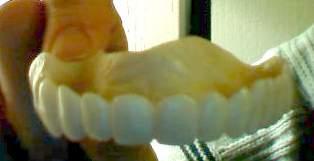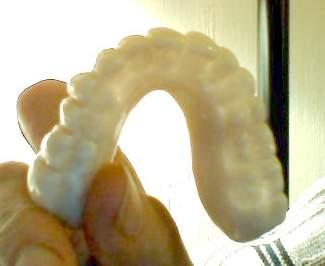
Newbie3
Members-
Posts
50 -
Joined
Profile Information
-
Gender
Male
Recent Profile Visitors
The recent visitors block is disabled and is not being shown to other users.
Newbie3's Achievements
Newbie (1/14)
4
Reputation
-
Addendum, 2020-07-23 It's been a year and a half wearing the overdentures on my upper arch, with no problem at all. They're very comfortable, and an easy and complete removal for cleaning is a real advantage. As mentioned in the original post, at night I'll wear my night guard, as it's much smaller, just covering the top of the teeth, and thus allows free flow of saliva. I purchased the night guard 3.5 years ago, specifying Lucitone FRS (a nylon resin rather than the default acrylic) and it's still going strong! The overdenture is so comfortable and protected the upper teeth so well, that in February 2020 I had some overdentures made for my lower teeth, to protect the lower gums, etc. Five months later and I'm still quite happy with this arrangement. No longer does food get stuck between my teeth and gums, my bite is improved, and my teeth well-protected. The only negative I've encountered with having both upper and lower overdentures is that all biting/grinding is done between two sets of (not sharp) plastic teeth. So, it's not the super-sharp ultra-hard natural enamel, but rather relatively soft plastic. Foods such as popcorn no longer can be easily ground to a fine slurry, but rather are flattened into something that looks like oatmeal flakes, unless chewed intentionally. Maybe in the future this problem might be solved by using a different material on the overdentures' food-grinding surfaces, when there are both upper and lower overdentures in use. Oh, one other item that might be considered a negative... (or a positive!): Overdentures do not require grinding the teeth down to "pegs", which are required for crowns as crowns must fit into the same space as the original teeth. With crowns, natural enamel and original tooth material are lost. A positive with overdentures is you keep all your original tooth material, because no grinding to pegs is required. This could make the difference in the future between keeping a tooth or losing it. The negative is that, because no grinding is done, overdentures are somewhat "larger than life" to fit over the teeth. But that can make for a beautiful smile. Your experience with overdentures may vary. Please see the Disclaimer at the top of the original post.
-
Thank you, everyone, for your contributions. From expert advice earned from years of experience, to valuable laymen's experiences, all are most helpful. I learned a lot! Thanks again.
- 26 replies
-
- 1
-

-
- fiber optic
- ilox
-
(and 1 more)
Tagged with:
-
From what little I understand, adding lots of new subscribers does not degrade DSL (as each subscriber has separate, physical wires to the telco), but will degrade cable internet (which has a shared circuit). What about fiber optic?
- 26 replies
-
- fiber optic
- ilox
-
(and 1 more)
Tagged with:
-
Would 20 minutes of keeping the milk at a simmer (with bubbles coming up, a slow boil) for 20 minutes do the job? I'd read that 13 minutes at sea level will kill most water-borne parasites... Plus a minute for every 1,000 feet in elevation. So that's another 5 minutes, plus an extra couple minutes for a safety margin, so that's 20 minutes total).
-
I don't know what Dental Express' policy is regarding walk-ins. I would suggest giving them a call and ask for a free consultation with Dr. Edgard or Dr. Rodrigo, whoever has the next available opening. Dr. Rodrigo did the actual overdenture work. Dr. Sergio also has experience with overdentures (I've never met him). The same design that holds a nightguard in place. I think it's made just a little smaller than the actual teeth, so the overdenture "snugs in". Also, it has protrusions that act as "space holders" for my missing teeth, to keep the remaining teeth from drifting into the gap at an angle, resulting in "bad bite". These space holders help keep the overdenture in place as well. I've haven't yet tried eating thick, gooey foods that create a suction when chewing. I suppose with time the overdenture might become somewhat loose. After two years, my night guard is somewhat loose, but still works fine. There is the option to "reline" to make it snug again, but that has its drawbacks (see original post).
-
[Disclaimer: I am not a medical practitioner. I'm simply relating my experience in case it's useful to you. Each person's situation is different. What works for me might not work for you. Please consult your dentist for professional counsel tailored to your unique situation.] This is not a widely-promoted option in the West, as mentioned by a dental research organization (based in India) in this study: The cost of the overdenture? 4900 MXN My overdenture is basically a heavy-duty plastic night guard that you wear during the day, at meals, etc. It's worn on the upper arch and covers and cushions all the upper teeth, thus protecting all the teeth in the mouth. It has a row of attractive faux teeth "fronts", which has improved my smile quite a bit, at a minimal cost to boot! Here's the front of my overdenture. You can see the nice white "picket fence" of faux teeth "fronts": Here's a top view, you can see the trough where my real upper teeth fit in behind the fronts: Here's an underside view: Notice how all my upper teeth are totally protected from abrasion, as well as from food particles getting forced into the gaps between the upper teeth and the gums, which eventually would've caused additional problems. This same surface protects my lower teeth as well, as they no longer grind into the upper teeth, but rather into the overdenture's (relatively) soft plastic -- the same protective principle as a night guard. In my case, because I have bruxism (unconscious grinding of teeth, particularly during sleep), the tops of my teeth have worn down. This worked in my favor, because this made room in my bite for the overdenture to fit in without having to grind down or modify my teeth! Also, I have enough natural teeth to fully support the overdenture, it just snaps into place, no implants, clasps, or hooks needed. All that was needed were some impressions to make the overdenture. If I had opted for crowns instead, my teeth would need to be ground ("tapered") so each crown would fit in the same space as the original tooth. I'm missing some lower teeth, and thus needed some bridges. Rather than expensive permanent bridges and implants, I opted for an RFD (Removable Flexible Denture -- bi-lateral bridge). I opted to have the framework made from Lucitone FRS, a nylon resin, which is considered more biocompatible than some other materials. I opted for the default acrylic teeth, to keep costs down. The RFD added another 4900 MXN to the total cost. Finally, I ordered a night guard. While I could've just used the overdenture and RFD for nighttime use as well, a night guard is much smaller, covering only the top third of the upper teeth (because appearance is not a factor) rather than the full height of the teeth and thus promotes unimpeded saliva flow overnight. My night guard cost 1100 MXN rather than 700 MXN, as I had it made of Lucitone FRS (for higher biocompatibility), which for night guards requires more labor, compared with the automated process for night guards. From what I understand it will last longer. So, the total cost for * one overdenture, for the top arch (4900 MXN) * one RFD, for the bottom arch (4900 MXN) * one night guard (1100 MXN) is 10,900 MXN. As one dental hygienist said, "Interestingly, the more complex and biologically incompatible the option, the more costly it is." Best of all, I can easily remove everything and give my teeth and gums a good cleaning as needed, unlike permanent bridgework and crowns. For the RFD, I found the following article from Dr. Mercola's website was quite informative (though I opted for the default acrylic teeth, for cost considerations): It's been two months since I got my overdenture, a year on my RFD, and two years on my night guard -- they're all working great! With this type of denture, if the fit becomes loose, it can be "relined", using what is called "cold patch" (as compared to the hot liquid plastic used when the denture is originally cast). A year ago I had an RFD repaired (that I'd dropped) using cold patch, but from then on I noticed a strong plastic taste after wearing the RFD for a while. From what I've read, cold-patch is less biocompatible then the original plastic. I want to thank the staff at Dental Express (in western Ajijic on the Carretera, 376-106-2080) for their support while on this journey: Dr. Edgard Macías, clinic director. An excellent communicator and teacher. Dr. Rodrigo Serrano, who said we'll work on this until it's right. And he did! It's very comfortable. Ivan Arrayga, dental lab lead technician. His painstaking work, in teamwork with Drs. Edgard and Rodrigo, was much appreciated. I would recommend them. * free consultations * reasonable prices * free shuttle ("in town") * in-house lab * modern equipment





